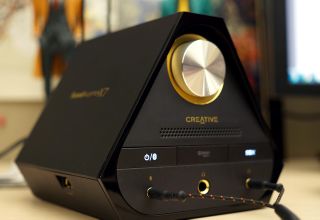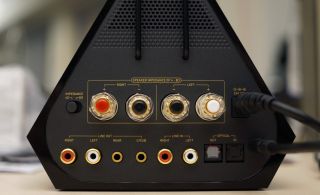Sound Blaster X7 tested: a powerful DAC with a $400 price tag

Before Sound Blaster showed me the X7, its $400 all-in-one audio DAC/amplifier, I asked the question that I thought most skeptical PC gamers would want to ask: Is there any need for a dedicated sound card these days, when motherboards seem to put out perfectly good audio? If you own a $500 pair of studio-quality headphones and already have a powerful sound card in your computer, you’re probably scoffing at the very idea. And that’s fine—if you already have that equipment, you also already know whether the X7 is for you or not.
Sound Blaster believes that motherboard sound quality isn’t good enough, and to that end the X7 is packed with powerful components that onboard audio can’t match. It’s a DAC (digital-analog converter) that can do 24-bit/192 kHz processing, and its amplifier can push up to 100 watts outto a pair of hefty speakers. It’s also absolutely packed with ports (speaker wire, analog, optical, ¼” headset) and features (Bluetooth, NFC pairing, beamforming mic) and supports 5.1 surround. Finally, the X7 comes with a software suite packed with options for tuning, calibrating, equalizing, and enhancing music and microphone audio. All of those features justify the Sound Blaster X7’s $400 price tag—if you use them. After spending a couple weeks with the X7, I think it’s a great piece of hardware, but unless you already have an expensive audio setup, it’s not worth the price.
A whole lot of hardware
As I started using the X7 daily to listen to music on a Steelseries 9H headset or through my JBL 2.1 speakers, I also researched digital-analog converters. They don’t come cheap, period, and you can easily spend $150 or $500 on a device specifically dedicated to processing digital audio and spitting it out to analog audio systems. That put the X7’s price in better perspective. Yeah, it’s expensive for a sound card, but reasonably priced for a feature-packed DAC.
There are a few things that separate the X7’s hardware from a motherboard sound chip, which essentially adds $0 to the cost of your PC build. Motherboard chips can introduce noise into sound as the signal travels across the board from the DSP (digital signal processor) to the audio jack. The X7’s 100 watt amplifier can output sound to a pair of passive speakers that motherboard audio normally couldn’t support. And, of course, it has all those connection options, which you normally won’t have with onboard audio.
Of course, you can get most of those perks in a cheaper DAC or sound card. The X7 makes a good case for dedicated audio, but most of its hardware features are wasted with a standard gaming headset or modest computer speaker setup. You don’t need a built-in amplifier for those, or the Bluetooth smartphone pairing.
I did find that music sounded better through the X7 than it did through the motherboard sound chip I have at work and the $25 Sound Blaster Audigy card I have at home. In fact, it sounded great. But that was more about software than hardware. For gamers who don’t already have high-end equipment, I think the X7’s software suite is its make-or-break feature, and though that software does help music sound great, I didn’t find most of its options especially useful.

A suite of software
The X7’s software suite includes pages of features: SBX Pro Studio, for tweaking audio sound, CrystalVoice for the mic, a mixer and equalizer, and Scout Mode for analyzing in-game audio and highlighting the sounds of enemy players (footsteps, bullets, etc.) for a competitive advantage. Most of these, unfortunately, didn’t feel especially useful to me; at least, not useful enough to pay $400 for. The software interface is at least well-organized, attractive, and stable. I didn't experience any crashes in several weeks of use.
The biggest gaming news, reviews and hardware deals
Keep up to date with the most important stories and the best deals, as picked by the PC Gamer team.
The Pro Studio settings let you fake surround sound, artificially amp up the bass, enhance movie dialogue over other sounds, and use the “crystalizer” to restore the audio details cut off at the high- and low-range of MP3 files. The crystalizer was my favorite setting, and it really did substantially improve the sound of music, at least to my ear.
Even listening with the Steelseries 9H headset, which is built for gaming, the X7’s crystalizer processing made music sound livelier and more full. It was a noticeable difference from running the headset with Direct Mode enabled (pure audio, no effects). I can’t say if the crystalizer was actually restoring the “true” sections of the audio waveform lost when a song is converted into a compressed digital file, but MP3s sounded consistently better, without a hint of artificiality that I could detect. Your taste for crystalizer will vary based on the sound equipment you have and the music files you listen to. If you exclusively listen to FLAC files on a pair of Sennheiser 598s, this setting is most definitely not for you.
The rest of the options in the X7’s control panel were less valuable to me. Surround did a passable job of simulating surround sound in my headphones, but it didn’t come close to a real surround sound experience, and didn’t make movies or games feel more immersive or enjoyable than the stereo audio my headset was built for. The gaming Scout Mode made audio sound artificial and distorted, and it did slightly enhance some sound effects, but I’d never want to use it for gaming. The mixer and equalizer are handy pages for tweaking audio volume and settings, but aren’t stand out features.

The built-in beamforming mic and its software settings didn’t work as well as I’d hoped. It’s nice being able to talk straight at the X7 without using a headset mic, and the microphone has a “focus” setting to narrow or widen the field of sound it can hear. Talking to a friend on Skype and adjusting the focus was never able to completely hide background noise, however. Its noise reduction and acoustic echo cancellation options also failed to produce a clean mic signal. My test subject reported hearing distorted background noise with those options enabled.
The echo cancellation is supposed to be able to cancel out the sound being processed through the X7, so that the game audio coming out of my speakers wouldn’t be picked up by the mic. In practice, my test subject wasn’t hearing everything, but he was hearing more background garbage than I wanted him to, and he reported that the audio overall sounded lower quality than my headset mic. I wouldn’t mind using the mic for occasional video conferencing when I don’t want to wear a headset, but it won’t replace my headset for regular gaming.
Wrapping up
After a few weeks with the Sound Blaster X7, I don’t think its hardware features or software offer a must-have draw for gamers with modest audio setups (though I do love its detachable headset stand, as minor a feature as that is). It’s a cool piece of hardware to have on your desk, assuming space isn’t an issue—the large metal volume knob feels great to spin and can mute music with an easy press. It sounds great and has the power to support some serious speakers. Audiophiles will be happy to hear that its op-amps are easily accessible via a flap on the bottom.
But that’s really who it’s for: audiophiles. If you have a killer headset or powerful speakers, it’s a versatile DAC that could also tie into your home stereo system, or play audio from your smartphone, or accept a ¼” headset output. I’d recommend most gamers buy a more affordable DAC to upgrade their PC from the motherboard audio slums. The Sound Blaster X7 is a premium piece of hardware with a premium price, and at $400, it’s simply too expensive for the majority of gamers.

Wes has been covering games and hardware for more than 10 years, first at tech sites like The Wirecutter and Tested before joining the PC Gamer team in 2014. Wes plays a little bit of everything, but he'll always jump at the chance to cover emulation and Japanese games.
When he's not obsessively optimizing and re-optimizing a tangle of conveyor belts in Satisfactory (it's really becoming a problem), he's probably playing a 20-year-old Final Fantasy or some opaque ASCII roguelike. With a focus on writing and editing features, he seeks out personal stories and in-depth histories from the corners of PC gaming and its niche communities. 50% pizza by volume (deep dish, to be specific).
Most Popular


